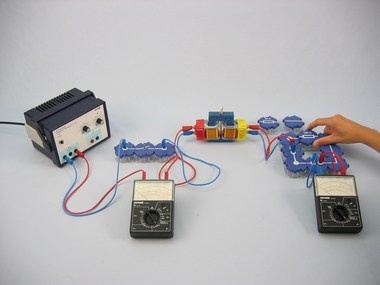Principle
When very high current strengths are required on a technical scale, e.g. for welding equipment or electric smelting furnaces, then so-called heavy current transformers are used. Their secondary coils have only a few turns of large diameter wire.
In the case of an ideal transformer under load, the primary and secondary performances are equal, so that Is ∕ Ip = Np ∕ Ns is valid. The students should recognise from this experiment that the ratio Is ∕ Ip increases with increasing load, so that Is ∕ Ip ≈ Np ∕ Ns is true for the transformer under load.
Benefits
- No additional cable connections between the building blocks needed - clear arragned and quick setup
- Contact saftey due to puzzle blocks system
- Corrosion-free gold plated contacts
- Doubled earning sucess: Electric circuit diagram on top, real components can be seen unterside
Tasks
How does a transformer perform under load?
Set up a model of a transformer and use it to examine which conformity to law is given when the transformer is under load.


